8.2 /10 1 Votes8.2
8.8/10 TV Developed by Jim JinkinsJoe Aaron First episode date 11 August 1991 | 7.6/10 IMDb | |||||||||||||||||||||||||||||||||
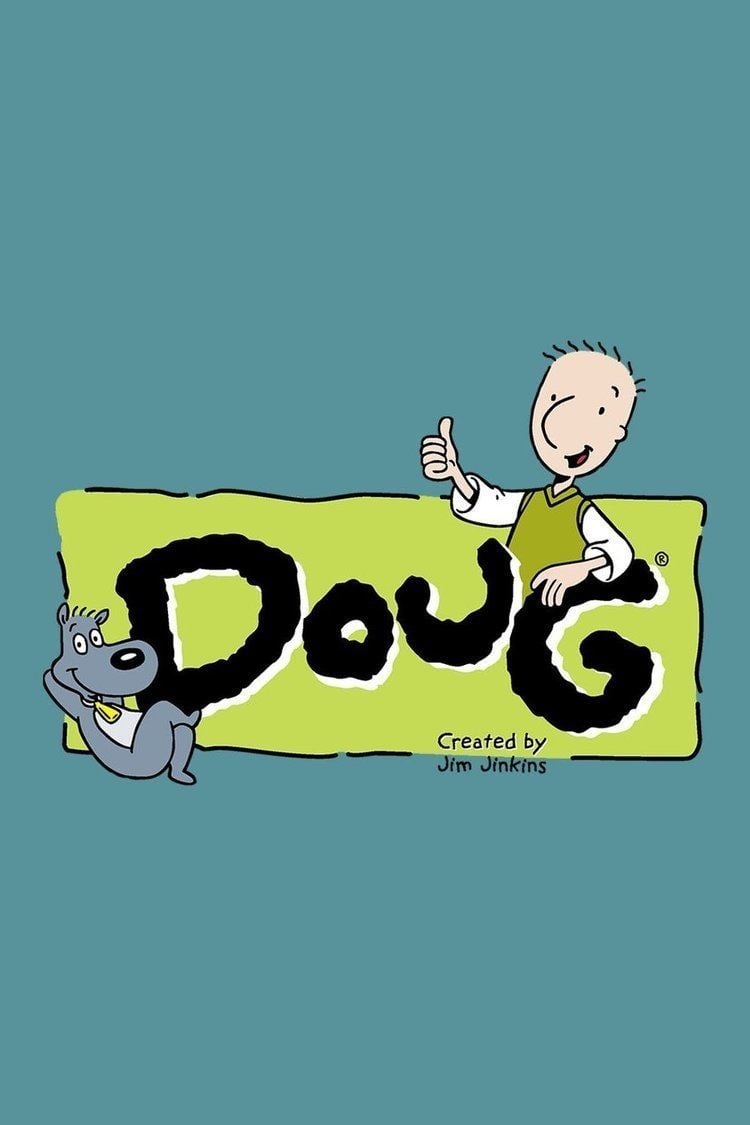 | ||||||||||||||||||||||||||||||||||
Genre Animated sitcomComedy-drama Voices of Billy West (1991–1994)Tom McHugh (1996–1999)Fred NewmanChris Phillips (1996–1999)Constance ShulmanEddie Korbich Cast Profiles | ||||||||||||||||||||||||||||||||||
Nickelodeon doug intro
Doug is an American animated sitcom created by Jim Jinkins. The show focuses on the early adolescent life of its title character, Douglas "Doug" Funnie, who experiences common predicaments while attending school in his new hometown of Bluffington. Doug narrates each story in his journal, and the show incorporates many imagination sequences. The series addresses numerous topics, including trying to fit in, platonic and romantic relationships, self-esteem, bullying, and rumors. Numerous episodes center on Doug's attempts to impress his classmate and crush, Patti Mayonnaise.
Contents
- Nickelodeon doug intro
- Tv show compilation doug the pug
- Premise
- Development
- Writing and design
- Music
- Disney acquisition
- Themes
- Broadcast history
- Foreign language editions
- Reception
- Ratings
- Awards and nominations
- Stage show
- Film
- Home video release
- References
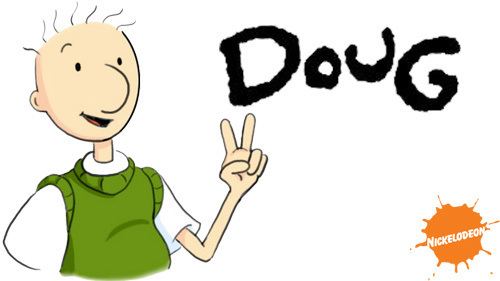
Jinkins developed Doug from drawings in his sketchbook that he created over the course of the 1980s. Doug, a mostly autobiographical creation, was largely inspired by Jinkins's childhood growing up in Virginia, with most characters in the series being based on real individuals. He first pitched Doug as a children's book to uninterested publishers before Nickelodeon purchased the show. Following this, the series went under further development, in which Jinkins meticulously detailed every aspect of the show's setting. Jinkins was insistent that the series have a purpose, and instructed writers to annotate each script with a moral. The show's unusual soundtrack consists largely of mouth noises.
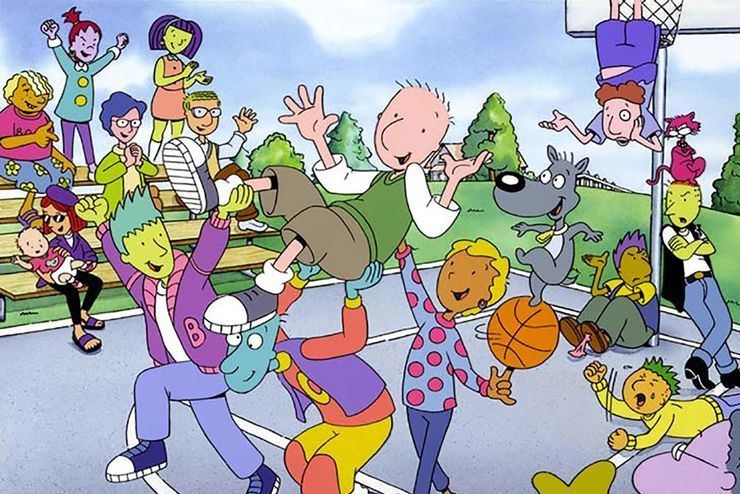
The series premiered in 1991 on the cable network Nickelodeon, as the channel's first original animated content alongside Rugrats and The Ren & Stimpy Show. The series' original run consisted of 52 episodes over four seasons that were broadcast from 1991 to 1994. In 1996, Disney acquired the series, retooling it with several creative changes, thus renaming it Brand Spanking New! Doug (retitled Disney's Doug in 1998), and airing it for three years on ABC's Saturday morning lineup. It became a top-rated show, inspiring various books, merchandise, a live musical stage show, and a theatrical feature, Doug's 1st Movie, released at the series' conclusion in 1999.
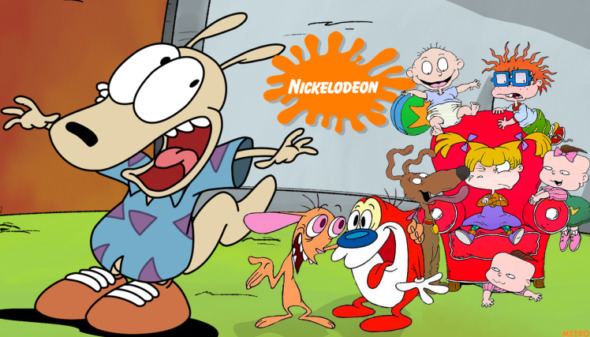
Tv show compilation doug the pug
Premise
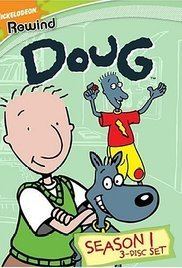
Doug follows the adventures of title character Doug Funnie, an 11½ year-old trying his best to deal with his fears of failure. He keeps a journal, recording his various experiences over the series, which range from learning to dance to getting a bad haircut. Doug Funnie and his family (which consists of his parents Theda and Phil, sister Judy, and dog Porkchop) move from the town of Bloatsburg to Bluffington after his dad receives a job promotion. Bluffington is located in the US, but not in any specific US state. However Bluffington is loosely based on the city of Richmond, Virginia, where creator Jim Jinkins was born and raised. Beyond the title character, Doug featured a large ensemble cast of characters. Many of the series' ancillary characters, among them Ms. Wingo and Mr. Spitz, are based on authority figures from Jinkins' childhood.
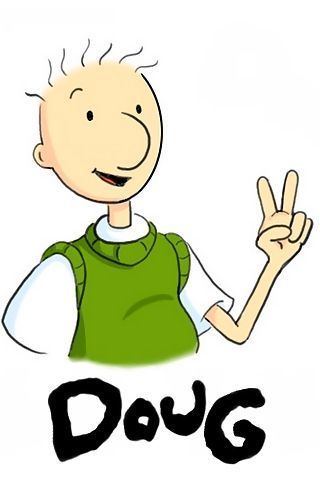
Development
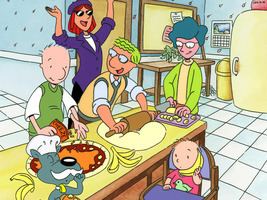
Doug was created by animator Jim Jinkins. He was born in Richmond, Virginia in 1953, and grew up fascinated by drawing. He went on to animation and filmmaking at Ohio State University, and upon graduation, got a job working at PBS in their children's programming unit. Jinkins first sketched the character of Doug while doodling without thought, not aiming to create a character based on himself. In the 1980s, he began working on an autobiographical character named "Brian", which he later changed to "Doug", as it was a very general, common name. He began to view the character as his "alter-ego," drawing him in variously cynical and silly scenarios in his sketchbook.
In 1984, Jinkins' career took a turn for the worse, as well as his personal life: he had a rough breakup and suffered injuries in a biking accident. During this time, he gained a new outlook on life. Desiring to "create a place where there was no overdue rent and no delinquent phone bills," he began doodling and formed the basis for Bluffington, the central location in Doug. The character's early designs were solidified alongside friend David Campbell at a small Mexican restaurant in New York. He later credited the character's odd coloring choices from being in a "margarita stupor." Campbell suggested he make Doug into a children's book, titled Doug Got a New Pair of Shoes, which was rejected by all of the city's publishing houses. Simon & Schuster was interested, but management changed before it purchased the pitch. The character made its first animated appearance in a 1988 Florida Grapefruit Growers commercial, and it was also used for a 1989 promotional bumper for the USA Network.
Meanwhile, cable network Nickelodeon, aiming to expand its content and find creative auteurs, began a search for animators to develop their first original animated series. This was very unusual for the time period, which often consisted of pre-licensed characters, such as Teenage Mutant Ninja Turtles and Where's Waldo?. Jinkins had actually worked at the network before it was renamed Nickelodeon; he was employed in the late 1970s when it was named Pinwheel. Jinkins set up a meeting with executive Vanessa Coffey to show her the book prototype. Coffey ran out of the room ("which is, you know, disturbing," Jinkins would recall), but only to inform her boss that "This [Jinkins] guy is the real deal, and we're taking him to pilot." Employing voice artists and writers from New York, Jinkins created a pilot for Doug, titled Doug Can't Dance. It was one of three six-minute pilots chosen out of eight to premiere as Nickelodeon's debut animated series, or Nicktoons. The long contract development took nearly a year to complete. Jinkins made sure that his contract allowed him to take the series to another network if Nickelodeon did not complete the show's order.
In another unusual move, Nickelodeon allowed their purchased pilots to be animated at independent studios. Jinkins founded Jumbo Pictures to produce Doug. He would later recall the oddity of the deal, remarking, "that was a moment in time where we were able to be an independent production company and deliver those shows." Coffey was the main executive in charge of the series' production, and Jinkins would later give her credit in bringing the show to air.
Writing and design
Jinkins characterized the series as not entirely autobiographical, but emotionally accurate to his childhood experiences. The show was designed and based off his experiences growing up in Virginia, designing it as such to give the viewers "a roller coaster of emotions." Each character in the series was based on people from Jinkins' life, with some exaggerations. Prior to the show's premiere, Jinkins sent messages to each subject of inspiration, notifying them of their inclusion. Jinkins' religious upbringing also made its way into the series, albeit without direct reference. For example, if an episode is set on Sunday, Doug's family is dressed in their church clothes. Jinkins felt it was important to not insert overly religious themes into the series, but he viewed it essential that each episode contain a moral. The series was also inspired by Peanuts.
The show's design was labor-intensive, intended to convey a certain logic to the show's universe. In the show's pitch bible, which Jinkins described as "huge," contain floor plans for each main character's homes, as well as maps of each street. In addition, Jinkins and the series' developers paid particular attention to more hidden elements within the series, such as the founding fathers of the show's central town. In writing the series, the production schedule was built around spending several weeks writing the series' scripts. Jinkins asked each writer to place a central theme at the top of each script — what issue Doug is dealing with, and what he learns. Jinkins often told staff that he wanted the show to remain relevant "in 30 years," aiming for a timeless effect. While developing the series, Jinkins wanted to change its name from Doug to The Funnies, but the network encouraged him to stick with the original name. There was a "cross-pollination" among the network's writing staff. This involved story editors being assigned to the show, among them Mitchell Kriegman of Clarissa Explains It All and Will McRobb of The Adventures of Pete & Pete. "There was definitely camaraderie and a quirkiness about who they were hiring," Jinkins later said. "Sometimes it didn't work quite so well, but working with McRobb was awesome!"
In translating the show to animation, the characters' designs were solidified. "Jim Jinkins is an illustrator and not an animator, so his initial drawings were a little bit more of a wiggly line," said Yvette Kaplan. The designs were inspired by Jinkins' period working for R. O. Blechman at the Ink Tank, incorporating Blechman's nervous line quality.
Music
Jinkins was also very involved in the show's music. One of the show's most notable elements is its unique soundtrack, which consist of various mouth sounds by voice actor Fred Newman. "Fred showed me how you could take out a guitar and use a tuna can filled with water that you'd thump with your finger," said Jinkins. In the series' Doug's favorite rock group is the Beets, a play on the Beatles. The band's members also visually resemble Ringo Starr of the Beatles and Robert Plant of Led Zeppelin, and their penchant for endless reunion tours owes to the Who. Jinkins viewed the series' music as an accent to the storytelling.
Creating the music for the series was a deliberate attempt to deviate from the standard for animated cartoons, which traditionally followed the works of Carl Stalling. The most complicated piece of music created for the series was for the opening sequence, which was recorded preceding animation, rather than the typical method of composing it afterward. Newman's scat singing plays over transitions in the series. The show also incorporated homemade sound effects.
In the closing credits for the first season of Nickelodeon's Doug, two different pieces of music would play: the first piece would be taken from the second story in the episode, and during the last third, Porkchop would don headphones and listen to music from the first story, immediately drowning out the original background music and angering Doug. Subsequent seasons, however, use a single piece of music for their closing credits (despite using the same animation). Starting with the Disney series, the credits have used Doug chasing Porkchop to the left and right while the credits play.
Disney acquisition
The original deal required Jumbo to produce 65 episodes of Doug, which Nickelodeon would air in blocks of 13 per season. After four seasons and 52 episodes of Doug, Nickelodeon declined to order the additional 13, citing the show's expensive budget. The network had a two-year window in which it could reverse the decision. The duo received strong interest from several networks, among them ABC. Each time they received interest, they would notify Nickelodeon in order to speed up ordering the series' fifth season. In 1996, The Walt Disney Company purchased ABC while also purchasing Doug in a multimillion-dollar deal with Jinkins and Campbell. The deal involved buying Jumbo Pictures and "signing them to five-year contracts, with stock options, to be Disney executives." The company also purchased the Doug trademark and its rights to all future merchandising.
Due to the gap in time it took between the series' run on Nickelodeon and its beginning on ABC, there were several creative changes. Billy West, the original voice of Doug, was replaced by Tom McHugh. Disney could not afford West, as his fame had grown from voicing characters in Ren & Stimpy and other animated properties. Jinkins argues that he worked hard to keep West on the series, claiming that the deal the company offered him was breaking their budget. Despite not returning to the Disney version, in 2013 West mentioned that he'd like Nickelodeon to resume production with the original Doug and to return as the role/character.
Many original staff members of Doug regard the Disney run as inferior. Jinkins was less hands-on regarding production of the show's Disney episodes due to other responsibilities. "I mostly agree with Doug fans who think the original 104 eleven-minute Doug stories made for Nick were the best", Jinkins later said. David Campbell felt the Nickelodeon episodes were "quirkier" and better, while Constance Shulman felt voice recording sessions were not the same in the show's newer incarnation: "I missed all the gang crammed in the studio, waiting for their turn for the big group scene. Someone just dimmed the magic a bit."
Themes
The series covers aspects of desiring to be different while coming of age. According to Jinkins, honesty is the series' main theme:
We put ourselves through enormous pain to avoid pain and I had this notion of: 'What if we didn't do that? What if we just told the truth?" he said. "But that's complicated. In the adult world, the notion of truth and not-truth is complicated, but I didn't want to debate it. I didn't want to show all of the ambiguity of the adult world to kids. I wanted to show kids a world where everyone took honesty seriously."
For example, the episode "Doug's in the Money" finds the titular character coming across an envelope of cash and returning it to its elderly owner. It created a heated debate among the series' writers regarding honesty. In the episode, Doug is rewarded with a stick of gum. "It comes down to how we think about who is involved in a story. In that case, I wanted Doug to do something that hurt where there was no tangible reward," said Jinkins.
After the series' completion, much online debate ensued over the race of Doug's best friend, Skeeter who some viewers felt exhibited traits stereotypical of African-Americans, and who subsequently drew conclusions that the character was intended to be African-American. Jinkins did not envision this discourse on the series' colors. When creating the show, he came across his 200 design markers and employed an array of bright, wild colors for the characters. Jinkins later told The Huffington Post in 2014 that the series' colors "came to symbolize the irrelevance of race."
Broadcast history
Nickelodeon series
Disney series
The Disney series aired from 1996 to 2003 on ABC and on UPN from 1999 to 2003. Reruns aired on Disney Channel from 2001 to 2004 and Toon Disney from 2001 to 2007.
Foreign language editions
The series premiered in Japan on Nickelodeon Japan in 1998 and ran until 2007 and then on Disney Channel Japan from 2003 to 2011. It has also been broadcast on NHK and Cartoon Network Japan at various times. All 117 episodes were dubbed and the same seiyuu lineup was used for both Nickelodeon and Disney episodes. The Japanese voice cast included Masako Nozawa (Doug), Konami Yoshida (Patti Mayonnaise), Masami Kikuchi (Skeeter), Akio Suyama (Roger), Yuriko Yamaguchi (Judy), Yuko Kobayashi (Theda), Keiichi Sonobe (Phil), and Tomomichi Nishimura (Mr. Dink) among others.
Reception
The series premiered alongside Rugrats and The Ren and Stimpy Show on August 11, 1991. The show was not as immediately popular as its counterparts, and Jinkins lamented to Coffey this fact. "Ren and Stimpy is getting so much attention because of [the show's creator] John Kricfalusi. I feel like the squeaky wheel gets the grease." Nickelodeon was largely attempting to push the limits of children's programming, while Doug was a much gentler, quiet show.
Ratings
The new Nicktoons block on Nickelodeon raised the network's ratings instantly. Doug constantly achieved over 2.0 in the network's most desirable demographics.
In its first season on ABC, Brand Spanking New Doug became the most popular program on ABC's Saturday morning lineup, attracting the highest ratings of any cartoon on the network. Its high-rated second season on the network contributed to its position as the number one network in Saturday morning ratings.
The show was later syndicated on various broadcast networks, including UPN.
Awards and nominations
Doug received numerous domestic and international awards and nominations. It won two Parents' Choice Awards, four Nickelodeon Kids' Choice Awards, and was nominated for three CableACE Awards and four Daytime Emmy Awards. It was also nominated for the Prix Jeunesse International Award.
Stage show
On March 15, 1999, Disney premiered a new musical stage show, "Doug Live!" at Disney's Hollywood Studios (at the time known as Disney-MGM Studios) at the Walt Disney World Resort. The show ran until May 12, 2002. Following the stage show, a version for Game Boy Color was released in 2000, titled Doug's Big Game.
Film
A theatrical feature-length film, Doug's 1st Movie was released on March 26, 1999, before production on the television show ceased. During this time, meet-and-greet costumed versions of Doug and Patti were seen in Disney World. The characters have been retired, but sometimes make appearances.
Home video release
Sony Wonder released a series of Doug videos between 1993 and 1996. Walt Disney Home Video released four videos of Disney's Doug in 1997; each collection featured two episodes.
In 2008, Nickelodeon partnered with Amazon.com to allow new and old programming to be made available on DVD through CreateSpace. As part of the deal, Amazon.com is responsible for producing the discs (on one time burnable media) on-demand as well as cover and disc art. Seasons 3 and 4 of Doug were released on DVD on December 8, 2009, and December 22, 2009, respectively.
Season 4 was supposed to be released as a complete season, but Nickelodeon was unable to locate two episodes from the final Nickelodeon season of the show, and opted to rename the DVD release Doug: The Best of Season 4.
All Nickelodeon episodes including the two that are missing from the season 4 DVD, are available from video on demand services such as iTunes Store, PlayStation Network, Zune Marketplace.
